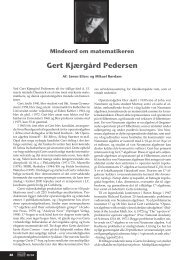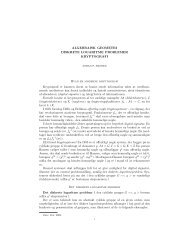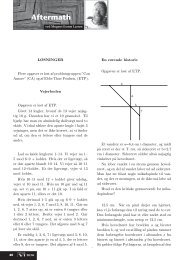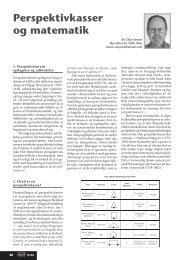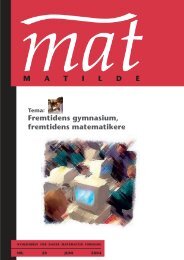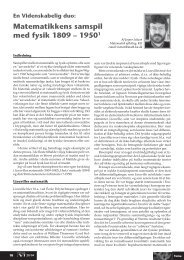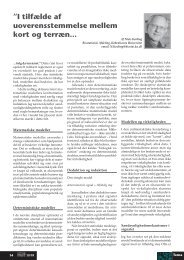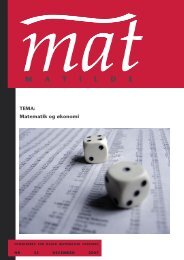TEMA - Matilde - Dansk Matematisk Forening
TEMA - Matilde - Dansk Matematisk Forening
TEMA - Matilde - Dansk Matematisk Forening
Create successful ePaper yourself
Turn your PDF publications into a flip-book with our unique Google optimized e-Paper software.
(i) We can buy risk free assets (e.g. bonds) with a fixed<br />
interest rate r ≥ 0. For simplicity we here assume<br />
that r = 0.<br />
(ii) We can buy risky assets (e.g. stocks). Let us denote<br />
the price of one stock at time t by S(t), where t = 0<br />
or t = T > 0. Assume that S(0) = 100 units, e.g.<br />
Danish Crowns (DKK). The price S(T ) at the future<br />
time T is uncertain at time t = 0. We assume that<br />
there are only two possible scenarios:<br />
Scenario 1: The price goes up to DKK 115 at time T . We<br />
assume that the probability p that this occurs is 1<br />
2 .<br />
In other words, P (Scenario 1) = p = 1<br />
2 , where P<br />
stands for ”probability”.<br />
Scenario 2: The price goes down to DKK 95 at time T . The<br />
probability 1 − p that this occurs is also 1.<br />
So we<br />
have P (Scenario 2) = 1 − p = 1<br />
2 .<br />
A European call option in this market is a contract which<br />
gives the buyer of the contract the right – but not the<br />
obligation – to buy one stock at the specified future time<br />
T and at a specified price K, usually called the exercise<br />
price. In this example we assume that K = DKK 105. See<br />
Figure 1.<br />
The question is:<br />
What is the ”right” price to pay for such a contract/option<br />
at time 0?<br />
The answer depends of course on what we mean by<br />
”right” price. Some people will say that the right price<br />
should be the expected payoff at time T . So let us compute<br />
this:<br />
Scenario 1: If the price goes up to DKK 115, then the<br />
buyer of the option can buy one stock for DKK 105, sell<br />
10 37/09<br />
t = 0<br />
stock<br />
price<br />
S(t)<br />
2<br />
it again for DKK 115 and thus get a payoff of DKK(115 −<br />
105) = DKK 10. This happens with probability p = 1<br />
2 .<br />
Scenario 2: If the price goes down to DKK 95, then the<br />
buyer will not exercise the option and the payoff is 0. This<br />
(= 1 − p).<br />
also happens with probability 1<br />
2<br />
We conclude that the expected payoff (wth respect to the<br />
probability law P ) for the buyer is<br />
EP [payoff] = 10 · 1 1<br />
2 + 0 · 2 = 5 (DKK). (2.1)<br />
(EP denotes expectation with respect to P ). Is this the<br />
right price to pay for the option at time 0? Perhaps surprisingly,<br />
the answer is no, if ”right” price is interpreted<br />
in an equilibrium sense. By this we mean the following:<br />
An arbitrage in this market is an investment policy at time<br />
0 which at time T gives a (strictly) positive profit with<br />
a (strictly) positive probability and a (strictly negative<br />
profit with probability 0. Thus an arbitrage is a kind of<br />
”money machine”, also called a ”free lunch”. There is<br />
no chance for a loss, and a positive chance for a positive<br />
profit. It is a basic equilibrium criterion for a financial<br />
market that arbitrages cannot exist. If a market had an arbitrage,<br />
then everybody would use it and the market would<br />
collapse. In view of this, we choose to define the ”right”<br />
price of an option as the price which does not lead to an<br />
arbitrage for buyer or seller.<br />
We claim that the expected payoff price DKK 5 found earlier<br />
gives an arbitrage opportunity to the seller of the option. Here<br />
is how:<br />
If the seller receives DKK 5 at time 0 for the option, she<br />
can borrow DKK 95 in the bank and use the total amount,<br />
DKK 100, to buy one stock. This stock she keeps till time<br />
T and then she sells it. There are now to possibilities:<br />
t = T<br />
Figure 1<br />
price 115 at time T with prob. 1 − p = 1<br />
2<br />
K = 105<br />
price 95 at time T with prob. p = 1<br />
2<br />
t



